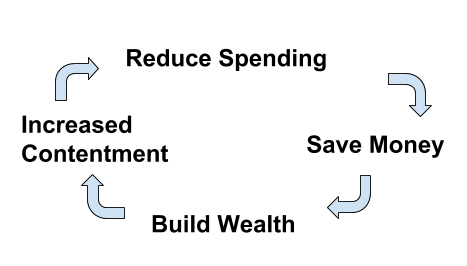Feedback loops are systems where the output is returned back to the input of the system, essentially causing the system to respond to itself. If you’ve ever been to a concert before, you are well aware of how a feedback loop works; the loud screech when a microphone picks up the sound coming from the speakers is a classic example.
Our lives are subject to feedback loops as well. Our ways of thinking and behaviors can quickly become feedback loops when our habits produce results that act on themselves.
The key to becoming more effective is to build more positive feedback loops into your life, and stop the negative ones.
Positive Life Feedback Loops
The positive feedback loops in our lives are the ones where your habits or ways of thinking actively work together to make you live a better life. You do something good, it produces a good result, which encourages you to do to more good.

One of my favorite examples is the reduction of spending on frivolous items. Building wealth and financial security, which makes your life simpler, can be built into this positive feedback loop.
Reducing your spending saves you money. Which in turns allows you to build wealth. With more financial security, you’ll be more content with your life. With developed contentment, you’ll have less of an urge to spend money on items.
You can probably think of other positive feedback loops you can build into your life as well:
Clean House > Less Clutter > Better Mindset > Clean House
Work out > Build Strength > More Energy > Work Out
The positive loops in our lives are effective at reinforcing good behaviors and encouraging the development of habits that help improve our lives.
Negative Life Feedback Loops
Unfortunately, it isn’t just positive habits that can be developed through feedback loops. You can just as easily develop negative patterns in your life that feed on themselves.

Anybody who has suffered from depression or anxiety knows all too well how these problems can build on themselves. The loop of negative thoughts, depression, and low self-worth can reinforce itself quickly, leading you to a bad place in life.
Another common and short negative loop is lack of exercise. If you are tired, you will not want to work out. If you do not work out, you will be tired. Eventually, you will begin to live a more and more sedentary life.
The negative feedback loops in your life build bad habits that feed upon themselves. You’ve heard the term “spiraled out of control before”, which is a great way of describing how a negative feedback loop can act over time.
Many of the negative habits that plague us are caused by feedback loops: poor eating, overspending, bad relationships, etc. It’s why identifying and breaking these harmful patterns is important.
Using Feedback Loops to Simplify Your Life
So now you know that feedback loops can be used to build positive habits in your life, as well as break negative ones. While each behavioral and cognitive loop has different actions and triggers, there are really only two steps to using feedback loops in your life:
- Recognize A Loop – In order to use a loop, you need to know it exists. Look at the outcome in your life you are trying to achieve/avoid, then trace back the steps to get there. What causes the outcome? If you examine the path, does it create a closed loop of behavior?
- Develop The Habit – Take action on the habit you are trying to develop. The benefit of looking at behavior as a loop is that it can make habits easier to reinforce. So whatever the steps are, be it eating better, your way of thinking, etc, get the loop started with action.
Dear business owner,
Do you wish to buy SEO services for your website [simplelivingdaily.com] to grow your business?
I would be happy to send you “Quotes”, “Proposal” Past work Details, “Our Packages”, and “Offers”, Take Complete Responsibility for improving your Presence etc.
Have a nice day 🙂
Kind Regards,
Terry Fowler – (SEO Analytics)
Ethical SEO -> Better Traffic -> Higher Sales -> Ecommerce Developer